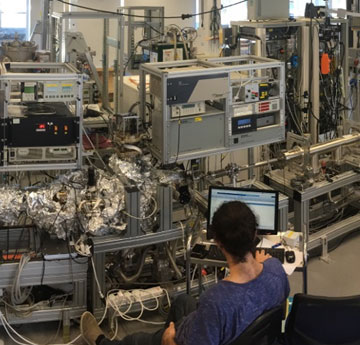Understanding the outcome of a collision between a gas molecule and a solid surface is crucial to many processes that rely on such collisions including industrial catalysis used to create valuable chemicals, reactions which eliminate toxic or greenhouse gasses, catastrophic heating of space vehicles re-entering Earth’s atmosphere, and even the formation of stars and life itself.
A key question is whether a molecule, when it collides with a surface, will bounce back from the surface, adsorb intact on the surface, or react and break down into fragments.
One molecular property which can change the outcome of a collision is the rotational orientation of the molecule. However, the current understanding of this is very limited, as it is usually impossible to control or measure the orientation of a rotating molecule.
The surface dynamics group led by Professor Gil Alexandrowicz, based at Swansea University’s Chemistry department, is working on the 'Rotational Waves' research project, a major European Research Council (ERC) research programme.
The project aims to shed light on the role that the rotational orientation of a molecule plays in determining the outcome of a collision with a solid surface.
As part of the project, the team has developed a new type of experiment which has enabled them to assess two things:
- how the rotational orientation of the molecule, just before the collision, changes the scattering probabilities.
- how the collision, in turn, changes the orientation of the molecules ejected back into the gas phase.
The unique experimental apparatus developed by the group uses magnetic fields to both control and measure the rotational quantum states of ground state molecules before and after they collide with a surface, measurements which are impossible to gather using existing experimental techniques.
The experiments provided evidence of the changes to the quantum states of the molecules brought on by the collision, results which could not have been captured during previous experiments using traditional techniques.
The surface dynamics group has demonstrated, for the first time, an experimental determination of a scattering matrix which provides a particularly sensitive and valuable benchmark that can be used to develop and scrutinise theoretical models of surface systems.
Being able to model the outcome of a molecule-surface collision yields valuable insights for those working in surface-based chemistry and many other fields of study. A better understanding of molecule-surface interactions will also allow the design of new industrial applications and materials.









